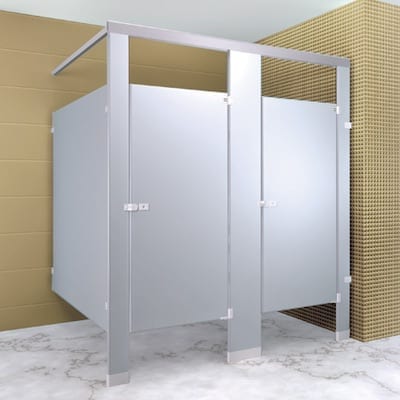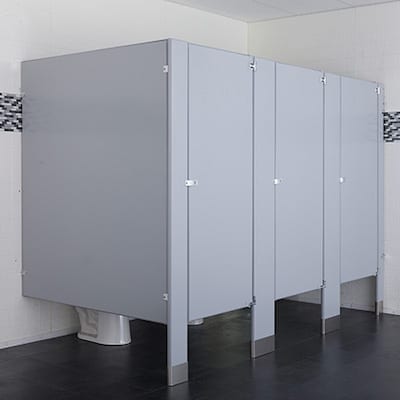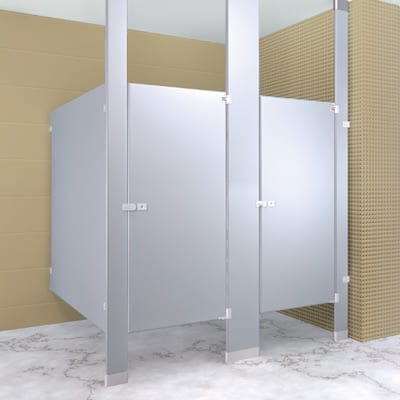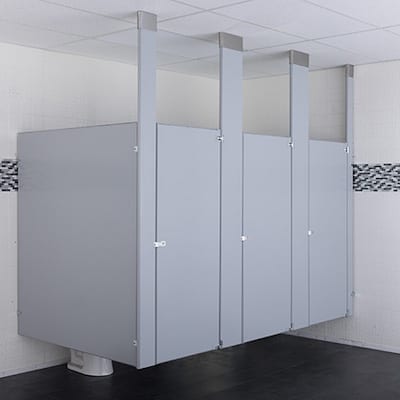When it comes to furnishing restrooms, the best toilet partitions for restaurants hinge on a handful of variables including the nature of the restaurant, the size of the bathroom, the money available to spend on partitions, and the owner’s personal preference.
At the end of the day, the owner’s personal preference might override all of the other variables, but that doesn’t mean it’s the best decision. All four variables above should be considered before making a purchase.
So, What are the Best Restaurant Bathroom Stalls?
Alongside the decisions above, there are generally four styles of toilet partitions used in restaurants and bars. They are as follows:
Overhead Braced

Floor Mounted

Floor to Ceiling

Ceiling Hung

There are structural conditions that apply to each of these styles, so it’s best to figure out which of these your building can take in.
For example, the Ceiling Hung style requires Unistrut installed in the ceiling to support the partitions’ weight. Another example is that the Floor Mounted option requires a 3” minimum thickness of concrete flooring to secure anchors for the footing.
If a restaurant is limited by these kinds of requirements, the options get slimmer and all the easier to make a selection.
What is the Nature of your Restaurant?
The restaurant’s nature should help pick the style of the partition. In other words, it should complement the restroom rather than look shabby compared to the rest of the business. Nor would it be a good idea to have the bathroom outshine the rest of the building.
Some restaurants can get away with simple partition styles using materials such as powder-coated steel or plastic partitions. Places like diners, pizzerias, or any kind of family-friendly type of restaurant (for lack of a better way to put it), can get away with cheaper styles and more basic materials.
However, the choice of materials should be strong and durable for these kinds of environments- even graffiti-proof. Powder-coated steel and solid plastic partitions are among the most common, most economical, and durable materials.
The same can’t be said for a high-end five-star restaurant located within a polished and fancier building décor. It wouldn’t compliment the rest of the business to have stalls that you’d expect to see in a diner in this case.
For the fancier, more expensive restaurants, different materials such as polished stainless steel or phenolic would make for a high-end, attractive, and durable set of options. It stands to reason that the fancier the restaurant, the fancier the bathroom looks should be.
The Size of the Restroom
The size of the restroom can play a big hand when selecting partitions. The bigger the restroom and the more plentiful the toilets, the more real estate you’ll need to cover with the partitions.
For price-sensitive projects, size can become a determining factor related to material types and partition styles. However, if the restroom is on the smaller side easier to splurge a little, knowing that you won’t have to purchase a bunch of partitions, maybe just a couple of stalls worth.
Like picking out tiles and wallpaper for a room, the partition style should make sense to the restroom’s size. If you pick out wallpaper with a wide pattern or large floor tiles, they will look better in a large room than in a small room. The same could be said about bathroom partitions.
If a bathroom is small, the partitions should be appropriate to make the best use of the available space. A more basic style of partition might be the best solution in this case for more general restaurants.
Fancier restaurants with small restrooms could get away with floor-to-ceiling options- offering the most private partition style- nearly a separate room for the toilet. Due to more material being involved, the floor-to-ceiling units are typically the most expensive style compared to others.
Economical Versus Lavish Restaurant Bathroom Stalls
Having a tight budget to spend on restroom furnishing can almost make your decisions for you when trying to figure out the best toilet partition for a restaurant. The more lavish materials and type options, the more expensive each stall will be.
This is why in most public bathrooms of just about any venue, but particularly large department stores, you’ll see that the bathroom is furnished with a basic style of partition. Powder-coated steel is often the material type you’d see, and the style is typically Overhead Braced/Floor Anchored. This is the most economical option between the material type and the style.
The Restaurant Owner
A large percentage of restaurants have owners that have their hand in every aspect of the business- including interior décor and restroom purchasing decisions.
Suppose the owner is surrounded by “yes men” and doesn’t have any sense of what would work out the best. In that case, they might wind up selecting a unit that doesn’t fit the restaurant scene at all but will personally like it.
At the end of the day, the owner will be paying for the partitions, and they can pretty much do what they see fit. However, if you’re a restaurant owner and need guidance on what style or partition, or material type best suits your situation, help is always available by whichever manufacturer you decide to go with.
You might hire professionals to come in and install the partition. Perhaps it wouldn’t be a bad idea to seek consultation from professionals to get the best partition ideas to match your business perfectly.
Conclusion
What do you have for space, how fancy of a restroom will the partitions be dwelling in, and what do you have to spend?
Those three factors should be decided before doing anything else.
From an economic standpoint, the best choice would be the overhead braced/Floor Anchored, powder-coated steel partition unit. For a higher sense of aesthetics, durability, and privacy, the floor-to-ceiling units made from high polished stainless steel (typically #8 polished 304 ss) would be a more expensive but more attractive option.

![PLATINUM_LI (1)[77]](https://www.granitestatespecialties.com/wp-content/uploads/2024/10/PLATINUM_LI-177-1.jpg)
